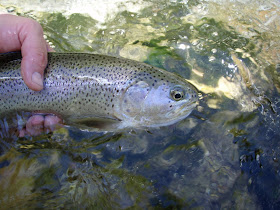Mist rises from the lake as pancakes and bacon cook over the fire. Nearby, a merganser and her chicks keep warm in a hollowed-out tree stump. Tim and I keep ourselves warm by sipping hot drinks on this bitterly cold 4th of July morning in Idaho's Upper Payette Lake National Forest Service campground.
 |
| Morning mist on Upper Payette Lake. |
 |
| Ready to cook breakfast on a chilly morning. |
Morning sun burns off the mist and the sparkling lake beckons. Tim inflates his float tube to try angling the icy water. Three osprey soar above the lake, searching for a fish breakfast. It’s a good sign, but Tim has only a few nibbles this morning. I have better luck bird-watching and spot brilliant blue/orange lazuli buntings and red/orange western tanagers.
 |
| Lazuli Bunting (left)—photo courtesy of planetofbirds.com and Western Tanager (right)—photo courtesy of allaboutbirds.com |
 |
| Tim fishes Upper Payette Lake. (He's in his float tube—the bright red speck in the center of the water.) |
In the afternoon we leave the campground and drive along the North Fork of the Payette River, searching for an ideal fishing spot. Tim descends a steep bank and fishes a couple deep pools by downed logs. The fishing isn’t great; Tim catches only one small trout.
 |
| Fly-fishing the North Fork of the Payette River. |
We return to the campsite and string the hammock between two lodgepole pines. Tim enjoys an afternoon siesta while I start the campfire. Dinner tonight is traditional camp fare—hot dogs with macaroni and cheese—but it’s a four-star meal in a setting like this. We inhale the pine-scented air and enjoy the quiet and the lake view.
 |
| This is the life! Tim relaxes at the campsite. |
After dinner the float tube is ready for another go on the lake; we notice plenty of fish hitting the surface. As Tim floats and casts in the lake I scan the area with my binoculars. Another merganser is swimming across the water, followed by seven baby chicks; mom is teaching these babies how to navigate the still waters.
I hear screeching overhead and look up to see an osprey gliding low, chased by a screaming bald eagle. The osprey drops the fish it's carrying and races away from the eagle. Another bald eagle swoops from the trees to join its mate, and together they cross the lake and disappear into the mountains.
It’s 10:30 p.m. and the sun is setting beyond Upper Payette Lake. Tim and I open a few packs of multi-colored sparklers and place them in the ground around our campsite.
As darkness falls we light the sparklers, creating our own mini-fireworks show deep in the north woods of Idaho. Happy Birthday, America!
 |
| Sparklers around the campfire at Upper Payette Lake, Idaho. |
****
USA readers, do you have memories from a special July 4th celebration?
Interested in traveling to Idaho and visiting this area of forests and lakes? Take a look at these two websites: http://www.recreation.gov/camping/Upper_Payette_Lake_Campground/r/campgroundDetails.do?contractCode=NRSO&parkId=74034&topTabIndex=Search
http://www.visitidaho.org/attraction/natural-attractions/payette-national-forest/
If you would like to read about another of my Idaho adventures, click here.
If you would like to read about another of my Idaho adventures, click here.
No blog post next week. In two weeks travel along with me to the Aloha State!





















